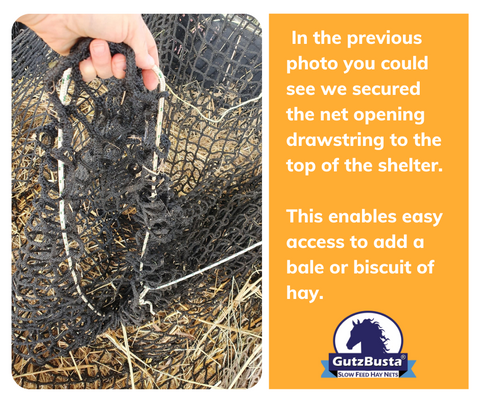Part 2 of our 3 Part Blog Series on the versatility of a GutzBusta Hay Net.
Scenario #3
Do you have a round bale that is nearing its end, but the horses are a little less keen to eat from it? We have had this happen recently with a bale of low sugar and therefore less palatable hay.
Solution, add a biscuit or 2 of something yummy or more palatable to 'mix' with the hay that is reluctantly being eaten. Or even add a whole small bale of a more palatable hay to mix around with and drive their enthusiasm to eat the remaining hay. Please note that in this scenario, there is nothing wrong with this hay, it is not mouldy and kept in a shelter, therefore we aren't forcing our horses to eat yucky hay.
This round bale has been kept under shelter and we have its opening top side, so I could tie the drawstring to the shelter. This enabled me to open it up, then put a biscuit or bale of hay into it. I then mixed this all together and hid the remaining biscuit or bale underneath some of the left-over hay. Since hay nets make it hard to 'sift' through the hay to find the yummy bits, the horses have to eat the hay they are a little more reluctant too first before getting to the yummier reward.
Once you have added your more palatable hay, simply pull up drawstring and re-secure the drawstring again. In this case, we re-tied the drawstring to the overhead beam.
Scenario #4
Another great thing I have personally had our hay nets aid me with is after baling our hay. For those of you that have never baled hay, there is always some left over hay in windrows that gets missed when baling occurs. Still being drought shy (from paying $180 for 5x4 round bales of pasture hay 😱), I couldn't let this 'hay' be left in the paddock.
For those of you that don't know, the pasture/lucerne/oats is cut with a mower/conditioner pulled behind a tractor. The mower puts this cut pasture/crop/lucerne into windrows depending on the settings you have it on. At appropriate times you go into the paddock with a tractor and rake and toss this chopped pasture/hay around so that it dries thoroughly AND you rake the hay into neat formed windrows for easier pick up with the baler. Once raked and dry enough, the hay is then ready to bale with a tractor and baler.

In January this year we baled 38 (4x4) round bales of hay off 3ac. Not bad for dryland hay making, amazing what RAIN can do!!
Armed with a stable rake, a quad bike, a round bale hay net and a trailer, I headed into the paddock. Using a 4x4 GutzBusta Round Bale hay net, I spread this out over the length and width of the trailer, drove to the spots where there was a fair amount of hay missed and proceeded to collect this hay off the ground and toss it into the hay net.

I ended up with 2x 4x4 nets full, so it was worth the effort. Obviously this hay was 'fluffy' and not compressed as it would be if baled, but none the less I recovered enough hay to serve 2 ponies for a couple of weeks.

After 'rolling' or man-handling one of these filled 4x4 nets into a home-made feeder we have, I then used the drawstring to secure the netting in several places by tying it to the metal frame. This then stopped the ponies from tossing the net with hay in it around the paddock since it is so much lighter due to only containing fluffed up collected hay.

This was part 2 of our 3 part Blog on just how versatile a GutzBusta Hay Net is and can offer so many ideas and solutions for managing your horses and livestock.









